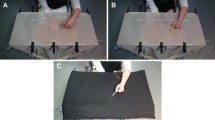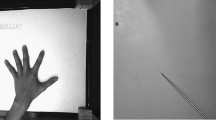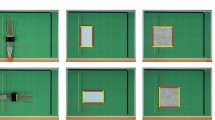Abstract
Hands play a fundamental role in everyday behaviour. Nevertheless, healthy adults show striking misrepresentations of their hands which have been documented by a wide range of studies addressing various aspects of body representation. For example, when asked to indicate the location within the hand of the knuckles, people place them substantially farther forward than they actually are. Previous research, however, has focused exclusively on the knuckles at the base of each finger, not considering the other knuckles in the fingers. This study, therefore, aimed to investigate conceptual knowledge of the structure of the whole hand, by investigating judgements of the location of all 14 knuckle joints in the hand. Participants localised each of the 14 knuckles of their own hand (Experiment 1) or of the experimenter’s hand (Experiment 2) on a hand silhouette. We measured whether there are systematic localisation biases. The results showed highly similar pattern of mislocalisation for the knuckles of one’s own hand and those of another person’s hand, suggesting that people share an abstract conceptual knowledge about the hand structure. In line with previous reports, we showed that the metacarpophalangeal joints at the base of the fingers are judged as substantially father forward in the hand than they actually are. Moreover, for the first time we showed a gradient of this bias, with progressive reduction of distal bias from more proximal to more distal joints. In sum, people think their finger segments are roughly the same, and that their fingers are shorter than they are.



Similar content being viewed by others
Availability of data and material
The datasets generated during and/or analysed during the current study are available from the corresponding author on reasonable request.
Code availability
The study was run under control of a custom MATLAB script using Cogent Graphics (developed by John Romaya, Laboratory of Neuroscience, Wellcome Department of Imaging Neuroscience, University College London), and the code is available upon from the corresponding author on reasonable request.
References
Alloway KD, Rosenthal P, Burton H (1989) Quantitative measurements of receptive field changes during antagonism of GABAergic transmission in primary somatosensory cortex of cats. Exp Brain Res 78:514–532
Ambroziak KB, Tamè L, Longo MR (2018) Conceptual distortions of hand structure are robust to changes in stimulus information. Conscious Cogn 61:107–116
Andersen ES (1978) Lexical universals of body-part terminology. In: Greenberg JH (ed) Universals of human language. Stanford University Press, Stanford, CA, pp 335–368
Bermúdez JL (1998) The paradox of self-consciousness. MIT Press, Cambridge, MA
Biederman I (1987) Recognition-by-components: A theory of human image understanding. Psychol Rev 94:115–147
Bracci S, Ietswaart M, Peelen MV, Cavina-Pratesi C (2010) Dissociable neural responses to hands and non-hand body parts in human left extrastriate visual cortex. J Neurophysiol 103:3389–3397
Bracci S, Cavina-Pratesi C, Ietswaart M, Caramazza A, Peelen MV (2012) Closely overlapping responses to tools and hands in left lateral occipitotemporal cortex. J Neurophysiol 107:1443–1456
Brooks VB, Rudomin P, Slayman CL (1961) Peripheral receptive fields of neurons in the cat’s cerebral cortex. J Neurophysiol 96:27–39
Brown CH (1976) General principles of human anatomical partonomy and speculations on the growth of partonomic nomenclature. Am Ethnol 3:400–424
Brown PB, Fuchs JL, Tapper DN (1975) Parametric studies of dorsal horn neurons responding to tactile stimulation. J Neurophysiol 38:19–25
Buxbaum LJ, Branch Coslett H (2001) Specialised structural descriptions for human body parts: evidence from autotopagnosia. Cogn Neuropsychol 18(4):289–306
Cardinali L, Serino A, Gori M (2019) Hand size underestimation grows during childhood. Scientific Reports 9:13191
Cholewiak RW, Collins AA (2003) Vibrotactile localization on the arm: effects of place, space, and age. Percept Psychophys 65(7):1058–1077
Cicmil N, Meyer AP, Stein JF (2016) Tactile toe agnosia and percept of a « missing toe » in healthy humans. Perception 45:265–280
Cody FWJ, Gaarside RAD, Lloyd D, Poliakoff E (2008) Tactile spatial acuity varies with site and axis in the human upper limb. Neurosci Lett 433:103–108
Corradi-Dell’Acqua C, Hesse MD, Rumiati RI, Fink GR (2008) Where is a nose with respect to a foot? The left posterior parietal cortex processes spatial relationships among body parts. Cereb Cortex 18(12):2879–2890
Coslett HB, Saffran EM, Schwoebel J (2002) Knowledge of the human body: a distinct semantic domain. Neurology 59(3):357–363
DiCarlo JJ, Johnson KO (2002) Receptive field structure in cortical area 3b of the alert monkey. Behav Brain Res 135:167–178
DiCarlo JJ, Johnson KO, Hsiao SS (1998) Structure of receptive fields in area 3b of primary somatosensory cortex in the alert monkey. J Neurosci 18:2626–2645
De Vignemont F, Majid A, Jola C, Haggard P (2009) Segmenting the body into parts: evidence from biases in tactile perception. Quart J Exp Psychol 62(3):500–512
De Vries JI, Visser GHA, Prechtl HF (1985) The emergence of fetal behaviour. II Quantitative aspects Early human development 12(2):99–120
Dolgilevica K, Longo MR, Tamè L (2020) Structural representations of fingers rely on both anatomical and spatial reference frames. J Exp Psychol Hum Percept Perform 46:125–130
Fausey CM, Jayaraman S, Smith LB (2016) From faces to hands: changing visual input in the first two years. Cognition 152:101–107
Felician O, Romaigučre P, Anton J-L, Nazarian B, Roth M, Poncet M et al (2004) The role of human left superior parietal lobule in body part localization. Ann Neurol 55:749–751
Fiori F, Longo MR (2018) Tactile distance illusions reflect a coherent stretch of tactile space. Proc Natl Acad Sci 115:1238–1243
Gardner EP, Spencer WA (1972) Sensory funneling. I. Psychophysical observations of human subjects and responses of cutaneous mechanoreceptive afferents in the cat to patterned skin stimuli. J Neurophysiol 35:925–953
Gerstmann J (1942) Problem of imperception of disease and of impaired body territories with organic lesions: relation to body scheme and its disorders. Arch Neurol Psychiatry 48:890–913
Gibson JJ (1962) Observations on active touch. Psychol Rev 69:477–491
Giurgola S, Bolognini N, Nava E (2020) Perceptual representation of own hand size in early childhood and adulthood. Sci Rep 10:5378
Goldin-Meadow S, Wagner SM (2005) How our hands help us learn. Trends Cogn Sci 9(5):234–241
Goldin-Meadow S (2003) Hearing gesture: how our hands help us think. Harvard University Press, Cambridge
Huang, K. L., Lin, W., Lu, C. C., & Pi, Y. S. (2019). Study on baby toy design—From the perspective of audio-visual human factors. In International Conference on Human-Computer Interaction (pp. 155–166). Springer, Cham.
Iverson JM, Goldin-Meadow S (2005) Gesture paves the way for language development. Psychol Sci 16(5):367–371
Kemmerer D, Tranel D (2008) Searching for the elusive neural substrates of body part terms: a neuropsychological study. Cogn Neuropsychol 25:601–629
Kinsbourne M (1998) Awareness of one’s own body: an attentional theory of its nature, development, and brain basis. In: Bermúdez J-L, Eilan N, Marcel A (eds) The body and the self. MIT Press, Cambridge, MA, pp 205–223
Kinsbourne M, Warrington EK (1962) A study of finger agnosia. Brain 85:47–66
Klatzky RL, Lederman SJ (1992) Stages of manual exploration in haptic object identification. Percept Psychophys 52(6):661–670
Laiacona M, Allamano N, Lorenzi L, Capitani E (2006) A case of impaired naming and knowledge of body parts: are limbs a separate category? Neurocase 12:307–316
Le Cornu Knight F, Bremner AJ, Cowie D (2020) Does the language we use to segment the body, shape the way we perceive it? A study of tactile perceptual distortions. Cognition 197:104127
Le Cornu Knight F, Cowie D, Bremner AJ (2017) Part-based representations of the body in early childhood: evidence from perceived distortions of tactile space across limb boundaries. Dev Sci 20(6):e12439
Le Cornu Knight F, Longo MR, Bremner AJ (2014) Categorical perception of tactile distance. Cognition 131:254–262
Lewis OJ (1989) Functional morphology of the evolving hand and foot. Clarendon Press, Oxford
Linkenauger SA, Wong HY, Geuss M, Stefanucci JK, McCulloch KC et al (2015) The perceptual homunculus: the perception of the relative proportions of the human body. J Exp Psychol Gen 144:103–113
Linkenauger SA, Kirby LR, McColloch KC, Longo MR (2017) People watching: the perception of the relative proportions of the self and others. Cortex 92:1–7
Longo MR (2014) The effects of immediate vision on implicit hand maps. Exp Brain Res 232(4):1241–1247
Longo MR (2015a) Posture modulates implicit hand maps. Conscious Cogn 36:96–102
Longo, M. R. (in press). Tactile distance anisotropy on the palm: a meta-analysis. Attention, perception, & psychophysics.
Longo MR (2015b) Intuitive anatomy: distortions of conceptual knowledge of hand structure. Cognition 142:230–235
Longo MR, Ghosh A, Yahya T (2015a) Bilateral symmetry of distortions of tactile size perception. Perception 44(11):1251–1262
Longo MR, Golubova O (2017) Mapping the internal geometry of tactile space. J Exp Psychol Hum Percept Perform 43(10):1815
Longo MR, Haggard P (2010) An implicit body representation underlying human position sense. Proc Natl Acad Sci 107(26):11727–11732
Longo MR, Haggard P (2011) Weber’s illusion and body shape: anisotropy of tactile size perception on the hand. J Exp Psychol Hum Percept Perform 37(3):720
Longo MR, Haggard P (2012a) Implicit body representations and the conscious body image. Acta Physiol (Oxf) 141(2):164–168
Longo MR, Haggard P (2012b) A 2.5-D representation of the human hand. J Exp Psychol Hum Percept Perform 38:9–13
Longo MR, Mancini F, Haggard P (2015b) Implicit body representations and tactile spatial remapping. Acta Physiol (Oxf) 160:77–87
Longo MR, Morcom R (2016) No correlation between distorted body representations underlying tactile distance perception and position sense. Front Human Neurosci 10:593
Longo MR, Mattioni S, Ganea N (2015c) Perceptual and conceptual distortions of implicit hand maps. Front Human Neurosci 9:656
Mancini F, Longo MR, Iannetti GD, Haggard P (2011) A supramodal representation of the body surface. Neuropsychologia 49:1194–1201
Margolis AN, Longo MR (2015) Visual detail about the body modulates tactile localisation biases. Exp Brain Res 233(2):351–358
Mattioni S, Longo MR (2014) The effects of verbal cueing on implicit hand maps. Acta Physiol (Oxf) 153:60–65
McClure EF (1975) Ethno-anatomy: the structure of the domain. Anthropol Linguist 17:78–88
McNeill D (1992) Hand and mind: what gesture reveals about thought. University of Chicago Press, Chicago, IL
Medina S, Tamè L, Longo MR (2018) Tactile localization biases are modulated by gaze direction. Exp Brain Res 236:31–42
Ogden JA (1985) Autotopagnosia: occurrence in a patient without nominal aphasia and with an intact ability to point to parts of animals and objects. Brain 108(4):1009–1022
Oldfield RC (1971) The assessment and analysis of handedness: the Edinburgh inventory. Neuropsychologia 9:97–113
Owen, R. (2007). On the nature of limbs. Chicago, IL: University of Chicago Press. (Original work published in 1849)
Penfield W, Boldrey E (1937) Somatic motor and sensory representation in the cerebral cortex of man as studied by electrical stimulation. Brain 60:389–443
Peviani V, Bottini G (2018) The distorted hand metric serves both perception and action. J Cogn Psychol 30:880–893
Piaget J (1952) The origins of intelligence in children. International Universities Press, New York
Rusconi E, Tamè L, Furlan M, Haggard P, Demarchi G, Adriani M, Ferrari P, Braun C, Schwarzbach J (2014) Neural correlates of finger gnosis. J Neurosci 34(27):9012–9023
Sadibolova R, Ferrè ER, Linkenauger SA, Longo MR (2019) Distortions of perceived volume and length of body parts. Cortex 111:74–86
Saulton A, Longo MR, Wong HY, Bülthoff HH, de la Rosa S (2016) The role of visual similarity and memory in body model distortions. Acta Physiol (Oxf) 164:103–111
Schlereth T, Magerl W, Treede R-D (2001) Spatial discrimination thesholds for pain and touch in the human hairy skin. Pain 92:187–194
Schwoebel J, Coslett HB (2005) Evidence for multiple, distinct representations of the human body. J Cogn Neurosci 17(4):543–553
Sirigu A, Grafman J, Bressler K, Sunderland T (1991) Multiple representations contribute to body knowledge processing. Evidence from a case of autotopagnosia. Brain 114:629–642
Sparling JW, Van Tol J, Chescheir NC (1999) Fetal and neonatal hand movement. Phys Ther 79(1):24–39
Steenbergen P, Buitenweg JR, Trojan J, Klaasen B, Veltink PH (2012) Subject-level differences in reported locations of cutaneous tactile and nociceptive stimuli. Front Hum Neurosci 6:325
Tamè L, Dransfield E, Quettier T, Longo MR (2017a) Finger posture modulates structural body representations. Sci Rep 7:43019
Tamè L, Bumpus N, Linkenauger SA, Longo MR (2017b) Distorted body representations are robust to differences in experimental instructions. Attent Percept Psychophys 79:1204–1216
Weber, E. H. (1996). De subtilitate tactus (H. E. Ross, Trans.). In H. E. Ross & D. J. Murray (Eds.), E. H. Weber on the tactile senses, 2nd ed (pp. 21–128). London: Academic Press. (Original work published 1834)
Weigel, M., Nittala, A. S., Olwal, A., & Steimle, J. (2017, May). Skinmarks: Enabling interactions on body landmarks using conformal skin electronics. In proceedings of the 2017 CHI Conference on Human Factors in Computing Systems (pp. 3095–3105).
Funding
This research was supported by a Grant from the European Research Council (ERC-2013-StG-336050) under the FP7 to MRL.
Author information
Authors and Affiliations
Contributions
LT, AF, MRL: Conceptualization; KM: Data curation, Formal analysis; MRL: Funding acquisition; Investigation; Methodology; KBA: Project administration; Resources; Software; MRL: Supervision, Validation; KM and MRL: Visualization; KM: Writing—original draft; MRL, LT, AF: Writing—review & editing.
Corresponding author
Ethics declarations
Conflict of interest
The authors declare that they have no conflict of interest.
Ethical approval
The procedures were approved by the Department of Psychological Sciences ethics committee at Birkbeck, University of London.
Consent to participate
All participants gave written informed consent and were paid for their participation.
Consent for publication
Participants signed informed consent to publish their data.
Additional information
Communicated by Francesco Lacquaniti.
Publisher's Note
Springer Nature remains neutral with regard to jurisdictional claims in published maps and institutional affiliations.
Rights and permissions
About this article
Cite this article
Myga, K.A., Ambroziak, K.B., Tamè, L. et al. Whole-hand perceptual maps of joint location. Exp Brain Res 239, 1235–1246 (2021). https://doi.org/10.1007/s00221-021-06043-6
Received:
Accepted:
Published:
Issue Date:
DOI: https://doi.org/10.1007/s00221-021-06043-6




